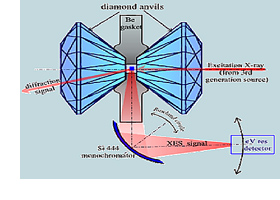Synchrotron x-ray diffraction
Stress/angle-resolved x-ray diffraction
X-ray Spectroscopy
Synchrotron X-Ray Diffraction
Structural studies at high pressures often rely on the ability to probe micro-samples, which can be achieved using intense x-ray beams from various synchrotron sources. Both second-generation (SSRL and NSLS) and third-generation (ESRF and APS) synchrotron sources are utilized for our high-pressure studies. At the SSRL, we use angle-dispersive x-ray diffraction using image-plate detectors for determination of crystal structures, mechanical elastic properties, and novel materials characterization at Mbar pressures. At the NSLS, we conduct in-situ energy-dispersive x-ray diffraction at high pressures and temperatures using both single- and double-side laser-heating systems. Various high-pressure experiments and developments are also in progress at third generation synchrotron sources, including HP-CAT at the APS.
Stress/Angle-Resolved X-Ray Diffraction
A complete description of the elastic properties of a solid can be obtained from the experimental determination of a single crystal compliance tensor. However, conventional experimental methods using acoustic scattering of light are typically limited to transparent, single crystals at low P,T; not applicable to opaque, polycrystalline aggregates at high P,T. The ultrasonic superposition or interference technique requires a single crystal to measure the individual elastic constants only at low P,T. On the other hand, synchrotron x-ray diffraction with a diamond anvil cell (DAC) is capable of measuring the compressibility of solids to very high P,T at near hydrostatic conditions. While such hydrostatic compression data provides limited, one-third, information of elastic constants (Cij), the additional information of Cij can be found by non-hydrostatic, uniaxial compression experiments of polycrystalline samples.
Under uniaxial compression, the Debye-Scherrer's diffraction rings become elliptically distorted due to the difference in each uniaxial stress component, s1 and s3, acting on the lattice plane d(hkl). The elliptical distortion, defined by a ratio of the d-spacings measured under nonhydrostatic (d) and hydrostatic (dp) conditions, is then a function of the angle Y between the diffracting d(hkl) plane and the compression axis s3. Therefore, by measuring the strains as a function of known (or calibrated) stress of the sample, one can obtain the detailed information of elastic constants. The detailed theory and formulae have been worked out for various crystal symmetries previously by Singh and colleagues (see A. Singh, J. Appl. Phys. 73(9), 4278, 1993). The angle-dependence of the elliptical distortion in the lattice can be most easily resolved by performing angle-resolved synchrotron x-ray diffraction with a polycrystalline sample in a DAC. Thus, we refer to this technique as Stress- and Angle-resolved X-ray Diffraction. Since SAX employs the same method as powder x-ray diffraction, the measurements can be made at megabar pressures and a few thousand degrees. Similar measurements were also made by using an energy-dispersive synchrotron x-ray diffraction.
X-Ray Spectroscopy
In X-ray Emission Spectroscopy (XES) 1s core-electrons are excited by high-energy "white" x-rays from an intense synchrotron source. The x-ray emissions are analyzed using a high-resolution (1eV) crystal analyzer to determine the filled electronic states of the sample. Because the final state of the fluorescence process is a one-hole state, XES directly probes the electronic density of states of the valence band and is sensitive to the magnetic polarization of the 3d band as well as to chemical shifts in the core-level binding energies of the sample.
For the 3d transition elements, the Kb line (3p->1s transition) contains information about the polarization of the valence band via the 3p–3d exchange interaction. The separation, ΔE, and intensity ratio, I'/I, of these multiplet transitions, can be used to determine the number of unpaired electrons in d-states, 2S, and the exchange integral, J, as ΔE = J(2S+1), and I'/I = 2S/(2S+2). X-ray Magnetic Circular Dichroism is an element-sensitive probe of the localized magnetic moments by using polarized synchrotron radiation and quarter-wave plates to measure the spin-dependent Kβ emission fine structures. However, while XES is sensitive to the total magnetization of the measured system, XMCD can discern between the contributions of different atoms in an alloy or multilayer, or between their orbital and spin moments.






